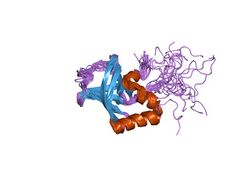Biology:PilZ domain
| PilZ | |||||||||
|---|---|---|---|---|---|---|---|---|---|
 the solution NMR structure of the protein of unknown function vca0042 from vibrio cholerae o1 | |||||||||
| Identifiers | |||||||||
| Symbol | PilZ | ||||||||
| Pfam | PF07238 | ||||||||
| InterPro | IPR009875 | ||||||||
| |||||||||
The PilZ protein family is named after the type IV pilus control protein first identified in Pseudomonas aeruginosa, expressed as part of the pil operon. It has a cytoplasmic location and is essential for type IV fimbrial, or pilus, biogenesis.[1] PilZ is a c-di-GMP binding domain and PilZ domain-containing proteins represent the best studied class of c-di-GMP effectors.[2] C-di-GMP, cyclic diguanosine monophosphate, the second messenger in cells, is widespread in and unique to the bacterial kingdom.[3] Elevated intracellular levels of c-di-GMP generally cause bacteria to change from a motile single-cell state to a sessile, adhesive surface-attached multicellular state called biofilm.[4][5]
Proteins which contain PilZ are known to interact with the flagellar switch-complex proteins FliG and FliM and this is mediated via the c-di-GMP-PliZ complex. This interaction results in a reduction of torque-generation and induces counterclockwise motor bias that slows the motor and induces counterclockwise rotation, inhibiting chemotaxis.[6]
Binding and mutagenesis studies of several PilZ domain proteins have shown that c-di-GMP binding depends on residues in RxxxR and D/NxSxxG sequence-motifs. The crystal structure, at 1.7 A, of a PilZ domain::c-di-GMP complex from Vibrio cholerae shows c-di-GMP contacting seven of nine strongly conserved residues. Binding of c-di-GMP causes a conformational switch whereby the C- and N-terminal domains are brought into close opposition forming a new allosteric interaction surface that spans these domains and the c-di-GMP at their interface.[7]
The PilZ domain is also implicated in the bacterial pathogenicity of the Lyme disease spirochaete, Borrelia burgdorferi, through its binding partner c-di-GMP.[8]
References
- ↑ "Identification of a novel gene, pilZ, essential for type 4 fimbrial biogenesis in Pseudomonas aeruginosa". J. Bacteriol. 178 (1): 46–53. January 1996. doi:10.1128/jb.178.1.46-53.1996. PMID 8550441.
- ↑ Ryjenkov, DA; Simm, R; Römling, U; Gomelsky, M (Oct 13, 2006). "The PilZ domain is a receptor for the second messenger c-di-GMP: the PilZ domain protein YcgR controls motility in enterobacteria.". The Journal of Biological Chemistry 281 (41): 30310–4. doi:10.1074/jbc.C600179200. PMID 16920715.
- ↑ Amikam, D; Galperin, MY (Jan 1, 2006). "PilZ domain is part of the bacterial c-di-GMP binding protein.". Bioinformatics 22 (1): 3–6. doi:10.1093/bioinformatics/bti739. PMID 16249258.
- ↑ Mattick, JS (2002). "Type IV pili and twitching motility.". Annual Review of Microbiology 56: 289–314. doi:10.1146/annurev.micro.56.012302.160938. PMID 12142488.
- ↑ Wolfe, AJ; Visick, KL (Jan 2008). "Get the message out: cyclic-Di-GMP regulates multiple levels of flagellum-based motility.". Journal of Bacteriology 190 (2): 463–75. doi:10.1128/JB.01418-07. PMID 17993515.
- ↑ Paul, K; Nieto, V; Carlquist, WC; Blair, DF; Harshey, RM (Apr 9, 2010). "The c-di-GMP binding protein YcgR controls flagellar motor direction and speed to affect chemotaxis by a "backstop brake" mechanism.". Molecular Cell 38 (1): 128–39. doi:10.1016/j.molcel.2010.03.001. PMID 20346719.
- ↑ Benach, J; Swaminathan, SS; Tamayo, R; Handelman, SK; Folta-Stogniew, E; Ramos, JE; Forouhar, F; Neely, H et al. (Dec 12, 2007). "The structural basis of cyclic diguanylate signal transduction by PilZ domains.". The EMBO Journal 26 (24): 5153–66. doi:10.1038/sj.emboj.7601918. PMID 18034161.
- ↑ Pitzer, JE; Sultan, SZ; Hayakawa, Y; Hobbs, G; Miller, MR; Motaleb, MA (May 2011). "Analysis of the Borrelia burgdorferi cyclic-di-GMP-binding protein PlzA reveals a role in motility and virulence.". Infection and Immunity 79 (5): 1815–25. doi:10.1128/IAI.00075-11. PMID 21357718.
 |

